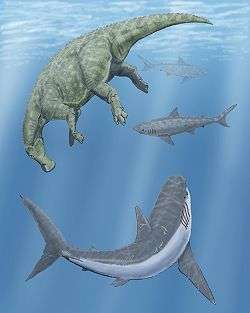Cretoxyrhina
| Cretoxyrhina Temporal range: Late Cretaceous, 100–82 Ma | |
|---|---|
| | |
| Tooth of a Cretoxyrhina mantelli, from New Jersey, USA; in the Naturhistorisches Museum (Vienna) | |
| Scientific classification | |
| Kingdom: | Animalia |
| Phylum: | Chordata |
| Class: | Chondrichthyes |
| Subclass: | Elasmobranchii |
| Superorder: | Selachimorpha |
| Order: | Lamniformes |
| Family: | †Cretoxyrhinidae |
| Genus: | Cretoxyrhina |
| Species: | C. mantelli |
| Binomial name | |
| Cretoxyrhina mantelli | |
Cretoxyrhina mantelli was a large shark that lived about 100 to 82 million years ago, during the late Cretaceous period. It is nicknamed the Ginsu shark in reference to the Ginsu knife,[1] since it fed by slicing into its victims with its knife-sharp teeth.[2] It had no common name in the early literature, although over 30 synonyms were assigned to it.[3] Its genus name is creto- (for "Cretaceous") prefixed to Oxyrhina ("sharp-nosed"), its original name.
Description

Cretoxyrhina is among the most well-understood fossil sharks to date. Several preserved specimens have revealed a great deal of insight about the physical features and lifestyle of this ancient predatory shark.
The fossil teeth of C. mantelli are up to 7 cm long,[4] curved, and smooth-edged, with a thick enamel coating.
The jaws of Cretoxyrhina contained up to seven rows of teeth, with 34 teeth in each row of its upper jaw and 36 in each row of its lower jaw.[3]
Cretoxyrhina mantelli grew up to 7 metres (23 ft) long,[1] and exceeded the extant great white shark, Carcharodon carharias, in size.
Discovery
This shark was first identified by the famous Swiss Naturalist Louis Agassiz, in 1843, as Cretoxyhrina mantelli. However, the most complete specimen of this shark was discovered in 1890, by the fossil hunter Charles H. Sternberg, who published his findings in 1907. The specimen comprised a nearly complete associated vertebral column and over 250 associated teeth. This kind of exceptional preservation of fossil sharks is rare, because a shark's skeleton is made of cartilage, which is not prone to fossilization. Charles dubbed the specimen Oxyrhina mantelli. This specimen represented a 20-foot-long (6.1 m) shark. It was excavated from Hackberry Creek, Gove County, Kansas.[3]
In later years, several other specimens have also been found. One such specimen was discovered in 1891 by George Sternberg, and was stored in a Munich museum. This specimen was also reported to be 20 feet long, but was destroyed during a bombing raid on Munich in World War II.[3]
Paleobiology

Cretoxyrhina was the largest shark in its time and was among the chief predators of the seas. Fossil records revealed that it preyed on a variety of marine animals, such as mosasaurs like Tylosaurus,[5] plesiosaurs like Elasmosaurus,[6] bony fish like Xiphactinus,[7] and protostegid turtles like Archelon.[8]
Paleoecology

This shark lived in Cenomanian–Campanian seas worldwide, including in the Western Interior Seaway of North America.[9]
See also
References
- 1 2 "Cretoxyrhina mantelli". National Geographic.
- ↑ Everhart, Mike (2009). "Cretoxyrhina mantelli, the Ginsu Shark".
Since the shark had no common name in the literature, and since it fed by ‘slicing’ up its victim into bite-size pieces, we [paleontologists K. Shimada and M. J. Everhart] decided that the title “Ginsu Shark”, was an appropriate, descriptive (and somewhat humorous) name for this awesome creature.
- 1 2 3 4 Everhart, Mike. "A giant Ginsu shark (Cretoxyrhina mantelli Agassiz) From Late Cretaceous Chalk of Kansas".
- ↑ Everhart, Mike. "Large Sharks in the Western Interior Sea".
- ↑ Rothschild, B. M. (2005). "Sharks eating mosasaurs, dead or alive?" (PDF). Netherlands Journal of Geosciencesvolume 21 (4): 335–340. Retrieved 2009-10-02.
- ↑ Everhart, M. J. (2005). "Bite marks on an elasmosaur (Sauropterygia; Plesiosauria) paddle from the Niobrara Chalk (Upper Cretaceous) as probable evidence of feeding by the lamniform shark, Cretoxyrhina mantelli" (PDF). PalArch’s Journal of Vertebrate Paleontology. Retrieved 2009-10-02.
- ↑ Shimada, Kenshu (1997). "Paleoecological relationships of the Late Cretaceous lamniform shark, Cretoxyrhina mantelli (Agassiz)". Journal of Paleontology. Retrieved 2009-10-02.
- ↑ Shimada, Kenshu; Hooks, G. E. (2004). "SHARK-BITTEN PROTOSTEGID TURTLES from the UPPER CRETACEOUS MOOREVILLE CHALK, ALABAMA". Journal of Paleontology. Retrieved 2009-10-02.
- ↑ Shimada, Kenshu; Cumbaa, S. L.; Rooyen, D. V. (2006). "Caudal Fin Skeleton of the LATE CRETACEOUS LAMNIFORM SHARK, CRETOXYRHINA MANTELLI, from the NIOBRARA CHALK OF KANSAS" (PDF). New Mexico Museum of Natural History. Retrieved 2009-10-02.
External links
| Wikimedia Commons has media related to Cretoxyrhina. |